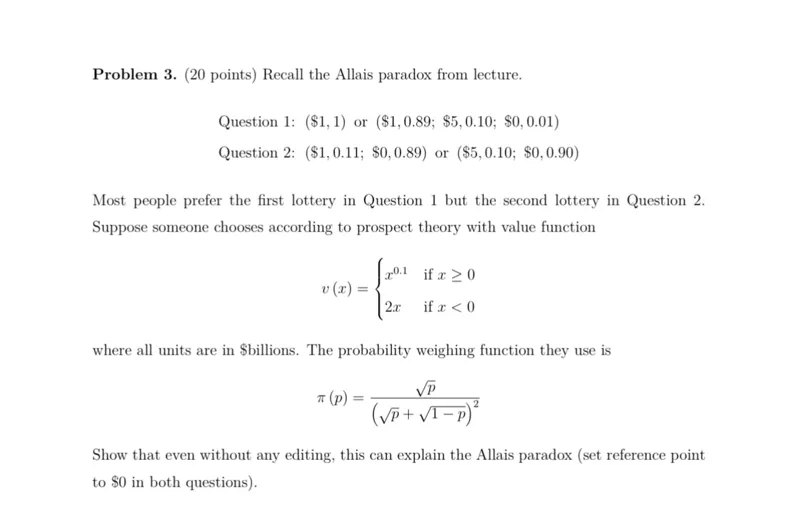Questions: Problem 3. (20 points) Recall the Allais paradox from lecture. Question 1: ( 1,1) or ( 1,0.89 ; 5,0.10 ; 0,0.01) Question 2: ( 1,0.11 ; 0,0.89) or ( 5,0.10 ; 0,0.90) Most people prefer the first lottery in Question 1 but the second lottery in Question 2. Suppose someone chooses according to prospect theory with value function v(x) = x^0.1 if x >= 0 2x if x<0 where all units are in billions. The probability weighing function they use is pi(p) = sqrt(p) / (sqrt(p) + sqrt(1-p))^2 Show that even without any editing, this can explain the Allais paradox (set reference point to 0 in both questions).

Transcript text: Problem 3. (20 points) Recall the Allais paradox from lecture.
Question 1: $(\$ 1,1)$ or $(\$ 1,0.89 ; \$ 5,0.10 ; \$ 0,0.01)$
Question 2: $(\$ 1,0.11 ; \$ 0,0.89)$ or $(\$ 5,0.10 ; \$ 0,0.90)$
Most people prefer the first lottery in Question 1 but the second lottery in Question 2. Suppose someone chooses according to prospect theory with value function
\[
v(x)=\left\{\begin{array}{ll}
x^{0.1} & \text { if } x \geq 0 \\
2 x & \text { if } x<0
\end{array}\right.
\]
where all units are in $\$$ billions. The probability weighing function they use is
\[
\pi(p)=\frac{\sqrt{p}}{(\sqrt{p}+\sqrt{1-p})^{2}}
\]
Show that even without any editing, this can explain the Allais paradox (set reference point to $\$ 0$ in both questions).





